#martial god of the east
Text
i only just recently got into Heaven Official's Blessing, but i don't think anything will ever beat the Windmaster looking at Lang Qiuanqiu hitching a fit about being bet for only half a steamed bun, immediately going "it's more than i would pay >:(" and then hiding his face behind his fan like he hadn't said anything at all
well aside from how tooth-rottingly in love Hualian is ofc
the dialogue in this franchise is top tier
"you're going to pay!"
"...for what?"
#what are y'alls favorite moments#mine is#“like you treasure me”#HE DOES#HE DOES XIE LIAN#heaven official's blessing#tgcf#hualian#wind master#lang qianqiu#martial god of the east#shi qingxuan#dialogue
85 notes
·
View notes
Text
"The martial gods of the southwest are your old acquaintances, martial god of the east is your disciple, green lantern wandering at night is your cousin, and the leader of ghost city, crimson rain sought flower is your sworn brother! And then there's me, the wind master, your friend!"
SWORN BROTHER
SWORN BROTHER
SHI QINGXUAN MY BELOVED YOU USUALLY GET THINGS RIGHT BUT YOU COULD NOT BE FURTHER FROM THE TRUTH
#mxtx novels#mxtx#tgcf#heaven official's blessing#hua cheng#mxtx tgcf#tgcf xie lian#xie lian#hualian#tgcf hua cheng#tgcf shi qingxuan#shi qingxuan#tian guan ci fu#heavens official blessing#tgcf sqx#sqx#feng xin#tgcf feng xin#tgcf mu qing#mu qing#tgcf qi rong#qi rong#lang qianqiu#tgcf s2#tgcf season 2#tgcf donghua
644 notes
·
View notes
Note
I'm writing a scene where a cultivater (chinese martial artists who fights ghosts) falls in a forest and I'm trying to figure out how someone who fights on rough terrain would train to fall. I tried looking at martial art/parkour/stunt man tutorials, but I feel like a lot of the basic techniques (rolling, and slapping the ground to distribute weight) wouldn't work well on uneven ground. I also tried looking at hiking advice but they just say to fall on your pack. Any insight?
Chinese cultivators don’t fall, they choose to reacquaint themselves with the ground.
That sounds like a joke, but the best way to understand Chinese cultivators and Chinese fantasy media is to realize that martial arts are the gateway drug to magic. And that will get you into a lot of trouble if you follow that all the way into Martial Arts Give You Superpowers, which is both the outgrowth of the western understanding of Chinese culture and a trope rife with orientalism. Cultivation seems simple on the surface when you’re watching Chinese media, but it’s more than martial arts, it’s more than religion, it’s more than mythology, (though it is all of those too) it’s a genuine transition into metaphysics that reorients how we understand and interact with the world around us. The concepts we see in cultivation come from real martial arts philosophy that you find in Tai Chi, Shaolin, and most other Chinese martial arts. They come from real religions including Daoism, Buddhism, a healthy dose of Confucianism, general mythology and mysticism from a wide range of subcultures, and, to an extent, Animism. If you aren’t doing your reading with the Eight Immortals, Journey to the West, The Legend of the White Snake, and others then you should dig in. I also really suggest watching the live action C-Dramas whether they’re true Wuxia or more Xianxia idol dramas (and in this case the idol dramas are better because the action is slower) so you can acquaint yourself with the stylized martial arts portrayals, a wide variety of choreography, character archetypes essential to motif based storytelling, and the most important aspect of all—wire work.
Understanding and conceptualizing stunt action done on wires is essential when you’re trying to visualize and create action scenes in any East Asian genre. Your first instinct might be to dismiss the stylized movement as unrealistic (it is) but remember that it’s also genre essential. Hong Kong action cinema has a very specific feel to it that’s very different from the way Western cinema structures and films their fight scenes. Even when you’re writing, you’ll want to find ways to imitate it through your visual imagery on the page.
Probably the best way to contextualize cultivators is that they’re wizards who do martial arts. They’ve learned to transcend the limitations in our understanding of reality through knowledge and study to perform superhuman feats. How superhuman? Well, it gets wild. They can be anywhere from Crouching Tiger, Hidden Dragon/Who Rules the World fly through the trees levels to Shang Tsung’s “I’m going to slam my hell reality into your normal reality because commuting to work is too much of an inconvenience.”
Which is to say, they don’t always fight ghosts. Sometimes they fight other martial artists, sometimes they fight other cultivators, sometimes they fight demons, sometimes they fight gods, and sometimes they fight incredibly overpowered monkeys. They’re often monks living in seclusion on a mountaintop, but not always. Cultivation is more of a state of mind. Anyone can do it if they learn how to absorb spiritual energy from the world around them through meditation and breathing exercises. Gods cultivate. Humans cultivate. Animals cultivate. Remember, the demons and the ghosts cultivate too. Sometimes, your master gets reincarnated as a demon. Sometimes, you do. The amount of wacky spellcasting you can do is dependent on how much energy you’ve cultivated, which is dependent on how old you are and how good at cultivation you are. Using the power means you need to cultivate more energy, the greater the spell or difficult the battle then the more energy is lost.
This is important to the question of: how does a cultivator fall?
Metaphorically? Existentially? Physically?
When we’re talking physically, wire work becomes very important. Think of your cultivator as being on wires. If they have the knowledge and understanding to do it, they can slow their own fall through the air to land harmlessly on the ground or twist over like a cat and launch themselves back off the ground to fly at their opponent in a counter attack. If they have the knowledge and understanding, they can teleport. If they lack the knowledge and understanding or want to trick their opponent, they can hit the ground like a sack of potatoes. If they’re relying on basics, they can also smack the ground to counter and spread out the impact then use the momentum from that fall to roll back onto their feet. They’ll do it no matter what terrain they’re on because it’s a basic technique that’s trained into their foundation to the point it’s a reflexive action. Any force distributed away from, and reducing impact on, important body parts like your spine is better than nothing. It’s better to sacrifice your arm than be paralyzed. At its heart, that’s the point of the technique. If you’re able to walk away with a functioning spine, it’s done its job. Your shoulder hurts? That’s normal. Your arm is sprained or broken? Sucks, but that’s better than the alternative that is paralysis and death. For reference, learning to fall was the first lesson my Wushu instructor ever taught me. It is that basic.
A lot of the time when portraying cultivators in media, the goal is to show them as being beyond the limitations of standard martial artists. How vast the gap is between the cultivator and the average human is dependent on both the setting and the cultivator. So, the average martial artist who possesses superhuman talents but hasn’t dedicated themselves to a life of cultivation and cultivators who are new to the path are going to be on the rung below and more likely to be knocked on their ass. Cultivators in the mid-range are more likely to have crafted or trained in solutions to being knocked on their ass which put them in a less vulnerable position while recovering and empowered/enhanced their martial arts. Cultivators in the top tier are usually straight up masters at spellcasting, if they deign to fight at all. Gravity need not apply. Rember, the time it takes you to hit the ground and roll to your feet is time your opponent has to launch a counter attack or move to a better position. Also, it means you’ve taken your eyes off your opponent. This is bad enough against a normal human opponent. Against another mostly immortal or ancient magic user this risks a terrible outcome.
Cunning and strategy are both as important as skill. Wisdom, knowledge, and hard work outweigh talent and raw potential. You’ll have to decide how esoteric you want to be and what limits you want to set. I really urge you to do this because the danger of power creep is real and especially prominent here. A character’s growth in power is often linked to their growth in character or their arc, as they gain a greater understanding of themselves and the world around them their skill increases. The self-discovery/self-reflection/self-interrogation/intense suffering to reach enlightenment portion is just as important and intrinsic to the martial arts portion of Martial Arts Give You Superpowers. It’s easy to focus on the Superpowers or the Martial Arts parts of the equation and miss the genre necessity of character growth. This growth often happens through heaps of steadily increasing trauma. Or, failing to undergo that by being too powerful and thus unable to progress is the joke like it is in Qi Refining for 3000 Years. (Go to hell, Bai Qiuran, you hilariously overpowered monstrosity.)
The irony is that the trajectory in character growth is the same trajectory the average student experiences when practicing martial arts. The only difference is that the power arc is inflated. This includes overcoming ingrained truths that you believe about yourself, about your own abilities, what you believe yourself to be capable of (both good and bad,) about your biases toward yourself and other people, your biases about reality in general, your understanding of good and evil, the potential upending of right and wrong, and facing the greater complexity found in the world at large. The stripping away of these illusions, coming to terms with uncomfortable realizations in a more complicated world, and the gaining of new understanding and confidence are vital to that growth.
Skill isn’t just represented in the power creep, it’s also found in a character’s sophistication and complexity in their approach to combat and life in general. Their awareness both of themselves and of other people, their ability to read intentions, their predictive abilities, their complexity in initiating their own strategy and tactics while also recognizing and countering the plans of others. It’s their insight into human nature and their cunning. It’s not enough to be powerful. The world is full of powerful people and not so powerful people who have the capacity to be just as dangerous. This isn’t Goku and Freeza slamming into each other while the planet explodes in nine minutes. You also need to be smart. It’s also not about being a better person. It’s about being a self-aware person. A person who is self-actualized. Monkey’s growth is in his awareness of the world around him through his experiences and in approaching problems differently rather than becoming less of a little shit. If you grow up in the West, one of the issues you’re going to face is thinking of these hurdles as materialistic rather than emotional or intellectual.
A lot of Western media misinterprets the concepts of “giving up” as physical sacrifice. One of the popular examples is physically sacrificing the person we love. In order to have enlightenment, we must be separated from them. We can’t physically be with them anymore. Whereas under a Buddhist structure, what we are actually sacrificing is our own ignorance, our own preconceptions, and beliefs that keep the world comfortable. Under this structure, we’re sacrificing our preconceived notions of who our loved one is. The person that we invented when we first met and we must force ourselves to come to terms with who they really are. The outcome of this isn’t necessarily going to be bad, but it’s still painful. The person we think we love could be perfectly wonderful. However, they’re not who we imagined. If we choose to hold onto the illusion we created, to ignore the realization that the illusion is the person that we love, we’ll only end up causing ourselves and our loved one more pain. We must fall in love with them all over again. Coming to terms with that is painful. All pain comes from ignorance. In sacrificing, letting go of, or overcoming our ignorance, we grow.
These are the emotional, intellectual, and spiritual challenges necessary for a cultivator because they allow the cultivator to level up. Yes, level up. Whether this is coming from the influx of gaming culture into media at large or because the concept synergizes with the Buddhist goal of progressing through the Six Realms toward nirvana, leveling up is how a cultivator’s increasing power is often depicted. Of course, once we reach the next level we can’t go back except by falling or failing and are no longer the person we once were. This then gets mixed in with Daoist principles of finding divine understanding by living in harmony with the universe. The more understanding we gain of the world, the more energy we can absorb as a result, but our original goals may be lost or changed in the process. If a character begins their journey on the path of revenge, their newfound contextualization of the situation that caused them immense pain may force them to give that revenge up or find they don’t want revenge anymore.
Failure is also an option and often a common part of the story. These stories usually follow characters through multiple lives and rebirths over hundreds and even thousands of years, especially if they’re also gods. This is the existential fall. The fall to the Dark Side. All our heroes are going to go through it at least once. This is also why a lot of Chinese media ends in tragedy with hope for the next round.
-Michi
This blog is supported through Patreon. Patrons get access to new posts three days early, and direct access to us through Discord. If you’re already a Patron, thank you. If you’d like to support us, please consider becoming a Patron.
449 notes
·
View notes
Text


QIURONG!!! 😝😝😝 u know the ship with lang qianqiu that martial god of the east everyone forgets is in TGCF
624 notes
·
View notes
Note
this might be controversial to some people but i believe there should be some cross pollination between the d&d unsure-if-they-want-to-be-bruce-lee-or-goku style monks and friar-john-with-no-hair-on-top-of-his-head style monks. let the friars shoot god's favorite kamehameha, at least once.
I think you're 100% right and I know for a fact that there was a brief period of time in the 80s when this was the case! Like, D&D had a Monk class but someone didn't get the memo that it was supposed to be based on East Asian martial artists, so there are some miniatures from the period where Monks (the class) are depicted like European friars doing kung fu
Like, check it out

180 notes
·
View notes
Text
I'm Publishing Serial Webnovels
Hi guys! I'm @elvensemi, and some of you might know me from writing Dragon Age fanfic Keeping Secrets, or from writing weird gargoyle porn with @unpretty, or from that time I accidentally told a popular blog I write dragon porn on my main blog @solitarelee, or maybe from that one fanfic where the knight with a crossdressing kink fails at slaying a dragon so hard he gets seduced!
I've graduated college, and you know what that means! Student loans Free time! And so I'm finally pursuing my long term dream and publishing serial webnovels. The short version is: ebooks, I'm publishing ebooks via Patreon to see if it works because I don't want to deal with Amazon and marketplaces. Chuck Tingle does it, kind of!
I am writing such things as!
The Problem with Faeries
An urban fantasy series for fans of Holly Black, featuring faeries and a librarian who has been cursed by a witch to turn into a tiny dog at night.
Everything at Once
A coming of age fantasy novel set in a post-post-apocalyptic world full of many monsters and very few humans, with a nonbinary (genderfluid) protagonist and a rotating cast of gods and monsters.
The Demon Isles
An adult romance series set in the same world as Everything at Once, this one's for the monsterf*ckers. Step into the shoes of an escaped slave who's been stranded in Fantasy Australia But All The Dangerous Things Can Be Seduced.
A Place Among the Stars
An adult sci-fi political space opera that is also technically just solidly omegaverse sm*t plus space dragons. That's right, one of my friends dared me to write omegaverse and I overdid it and now they're aliens! All for you my friend.
Novelizations of works that previously existed only as RPs, such as Sanctuary and The Kingdom of Aeris.
AND SO MUCH MORE.
For $5 you get access to SFW material, and for $10 you get access to that and the things that are not SFW. You can view a full summary of the serials I'm working on at tinyurl.com/SemiSerials , or click the read more.
The Demon Isles (NSFW, Second Person)
Oceanside is a world full of elves and gods, monsters and magic. You, however, a human with no magic, no martial training, and a fear of... most things. Stranded on an unfamiliar island full of monsters, you must learn to harness humanity’s true power in order to survive. The issue with that is, as far as anyone can tell, humanity’s true powers are friendship and fuckability.
The Demon Isles is a erotic, second-person monsterfucking romp through the dangerous Demon Isles. The second person character is referred to by gender neutral terminology and they/them pronouns, physical appearance left ambiguous. Sex scenes have two versions with different sets of genitalia for the main character. Tags and content warnings are available for each chapter.
The Problem with Faeries (SFW, Third Person)
The problem with faeries is that we love them. We know all the sharp and cruel ways they twist us apart and we love them with a helpless, hopeless foolishness that never fades until it destroys us.
Bree is a human living in Valesport, a small town on the east coast of the United States that functions as a secret haven for the supernatural. As a cursed human, it’s one of the safer places for her... at least, safe from other humans. Everything else Valesport has to offer remains a threat. She’s already had her run-ins with werewolves, vampires, and whatever the hell Jean Cernunnos is... so, in retrospect, she was probably due to get into trouble with the Fae.
A fan favorite finally finding a venue of publication, The Problem with Faeries is a SFW urban fantasy with a side of romance perfect for fans of Holly Black. It is third person and follows the point of view of the protagonist, Bridget “Bree” Corey, as she finds herself tangled up trying to navigate faerie drama and her own personal feelings, neither of which she is particularly equipped to handle.
Everything at Once (SFW, First Person)
Babs wants everything the world has to offer... everything except what it’s actually prepared to hand over. As the eldest child of the ruling noble family--or what passes for it--of the only human village remaining old and large enough to still have a ruling noble family, even if just in name, Babs’s whole life has been laid out in front of them since the moment they were born. And they want none of it. However, after a bold escape from the village they knew all their life, they find themselves adrift in an unfriendly world of monsters and magic that seems much larger and much less friendly than they had hoped.
Everything at Once is a SFW fantasy novel set all over the world of Oceanside as our determined protagonist, Babs, attempts to explore all there is to explore and experience all there is to experience (it is possible they have not thought this through). Babs is a non-binary, gender fluid illusionist referred to varyingly by he, she, and they pronouns based on presentation. The story is a first person mixed POV exploring a wide range of characters and topics, but always staying focused on the many transformations of the main character as they learn what it is they want... and what it is to want.

Future Projects: Projects that are in development but do not have a set release date yet.
A Place Among the Stars [Working Title] (NSFW)
A Place Among the Stars is a NSFW erotic political space opera featuring Omegaverse style aliens and also space dragons, amongst other alien races. It features two protagonists: an exiled and excommunicated Saint who once led a cult that threatened the peace and stability of his homeworld, and a mid level government official presiding over the walled ghetto where the Ab’ed keep all foreign visitors and immigrants to their planet. They quickly find themselves entangled: politically, as the Saint once again threatens the stability of the world around him--in more ways than one--and sexually, as the tension between the two reaches a fever pitch.
Sanctuary (NSFW, Third Person)
Most people would consider Ren unlucky. After all, she’s been homeless since she was a child, has no living family she knows of, and she was recently kidnapped by sex traffickers and ripped away from the city she had been living in for years. But as far as Ren is concerned, she’s the epitome of good luck: not only has she survived all the things life has thrown at her, but she’s escaped said sex traffickers and even found shelter in an abandoned, boarded up cathedral. The fact that the cathedral, undisturbed for a century or more, is home to a guardian whose only experience with the world is violently murdering intruders, well... once again, whether that’s good or bad luck is based purely on interpretation.
Sanctuary is a NSFW urban fantasy erotic romance featuring a cis female protagonist and a male (as these things go) gargoyle love interest, as well as a mix of other romantic interests (primarily M/F with some F/F or NB/F thrown in). Tags and content warnings are available for each chapter. This fan-favorite returns in serialized, ebook form for easy reading. Follow Ren’s journey anew from mixed perspectives as she explores the streets of Valesport and finds something she’s never had before; a place to call home.
70 notes
·
View notes
Text
The Monkey King - Sun Wukong who first appears in Chinese stories (Journey to the West) during the Ming Dynasty period 1368 to 1644 CE, well after the introduction of Buddhism to China in about 206-220 CE.
But, was he inspired by another Monkey hero/character of myth?

The prevailing and dominant theory among Asian scholars is ...yeah, likely.
That character, Hanuman, king of the monkeys (the monkey people -Vanaras- of Vedic myth!).
The story follows a Buddhist monk who is accompanied by Sun Wukong and others to travel west to India to obtain sacred Buddhist sutras. Many of their powers and personality traits are similar as well.
We know that Vedic god such as Indra have made their way as far as Japan to take root and be worshipped because of the spread of Buddhism.
As I've talked about before and is shown in texts such as the journey's of Ibn Battuta / Ibn Fadlan, storytelling was a weapon and powerful tool for idea transfer--propagation. Philosophy was huge in the old world - and places such as Nalanda - the first residential university in the world - invited scholars from all over such as Greeks from the west, and the Japanese. Buddhism became a vehicle for trading things such as: martial arts information, medicine, sciences, and of course, myths and stories.
However, as with stories, people usually altered/coopted elements and molded them to better suit their cultures and fancy. That's a thing as old as time. I've shared how the panchatantra stories and jatka tales are thought to be the inspiration for nearly 30-50 percent of all nursery rhymes, ballads, "fairy tales".
Anyways back to this theory - Chinese Indologist Professor Liu Anwu of Peking University has dedicated chapters to the comparisons (in one of his works) to further break down this theory focusing on consistent and or similar depictions of beats in Journey to the West that of Rama's story in Ramayama and the Buddhist sutras.
Even though today the story of Sun Wukong is a wholly Chinese story - it's important to note the power of oral storytelling and how it travelled evolved over thousands of years, and, just as important, the vehicles it used to do so. Not just storytellers and philosophers and travelers but religion! Philosophy!
This is a theme heavily commented on and shown in Tales of Tremaine, which is my love letter and sort of self PhD. in comparative storytelling, mythology, and story foundry through an Asiatic lens (hence a silk road analog) stretching along a similar route the silk road did from damn near as far as you can east (complete with the oceanic routes) to as west as old venezia, portugal, and spain.
Also note: this is the most popular theory atm, but the operative word is theory. Experts likely far better than you, Internet, so chill before you comment, are still debating this. I know last week some of you were doctors in sociopolitical relations, the music industry before that, and then you were leading virologists before that. Spare us simpler folks from your mighty genius just now and sit down.
The point here is the beauty of stories and their ability to travel and morph and comment on themes/points ideologies important to cultures while being entertaining and showing that humans like certain universal moments, beats, archetypes, tropes, and progressions in tales.
Now, is that because we've naturally been predisposed liking them, or the opposite in that everyone went, yo, i dig this, took it home and someone else went, this is cool but needs to be more US (insert culture) and retold it. And thus...timemachine noises speed up. Here we are today?
You might not know that about 35,000 Chinese words ( I said this instead of Mandarin because they don't just show up in one language) are derived from Sanskrit as well as Pali (a Middle Indo-Aryan Liturgical Language -- meaning language of sacredness/religious use, in this case connected to sacred Buddhist texts). It is important to make the distinction, because, Internet!
Sanskrit did not SHAPE the Chinese languages. They evolved on their own. This is just a commentary on how words/stories shaped over travel in this case strongly through the spread of Buddhism.
Religion was the mover.
Back from quick bathroom break. Going to add again - INSPIRED is the keyword here.
INSPIRED.
Sun Wukong is his own mythos/character. Influence doesn't nor can claim dominion over everything in a later tale. Sun Wukong has gone on himself to inspire legends and characters Outside of China - re: most famously and legendary?
Son Goku - who is openly a Sun Wukong inspired character.
...hell, tbh, he might be the most famous monkey inspired super powered character now. Dude makes soccer stadiums air his fights. @_@.

#monkey king#monkey king journey to the west#hanuman#buddhist#buddhist monk#sun wukong#vedic gods#Japan#China#chinese legend#storytelling#mythology#myths and legends#asian mythology#mandarin#Sanskrit#pali#chinese language#dbz#dragon ball#dragon ball z#inspired#inspired by#the silk road#silk road retelling#philosophy#philosophers#journey to the west#fairy tales#nursery rhymes
26 notes
·
View notes
Text
Strong seawomen

You can read more about Iceland's seawomen here!
"Born in 1829, Ísafold Runólfsdóttir grew up on a remote farm in East Iceland near present-day Vopnafjördur. From a family celebrated for their singular strength, Ísafold was known as the best and strongest of the bunch. She was so renowned for her strength that she became part of the folk history of the area, with accounts of her taking on the form and style of the traditional Icelandic narrative tales. She is described as very intelligent, tall, broad-shouldered, handsome with a firm expression, bold, eager in her work, unsparing in her words, unafraid to speak her mind (her language sometimes a bit crass) and overall considered a hero both at sea and on land.
Ísafold went to sea when she was “very young,” first rowing with her father Runólfur. Fishing became her main source of income. She often went out alone, and only the “hardest workers could hope to match her.” As with so many of the seawomen in the historical record, it was not so much for her fishing that Ísafold is remembered but for her personality and phenomenal strength. This included her ability to pull her heavy wooden boat ashore alone—an unheard-of feat. One young seaman recalled that once, when the boat was getting in danger upon encountering rough waves as they neared shore, Ísafold jumped from the boat into the waves, grabbed him, and then tossed him with such a throw that he landed safely on shore. Then she dragged the boat ashore after her. Another account describes how, when unloading hundred-pound bags from the boats with the men, who carried one bag each, Ísafold would often remark, “Well, you are not so strong,” and grab two bags, one in each hand.6 Some speculated that it was the fish oil she took religiously that aided her famous strength—but that she was stronger than almost anyone else, man or woman, was undisputed.
Ísafold also had exceptional skill and strength at a wrestling and martial art form called glíma. Brought from Norway by the early Icelandic settlers, glíma was played in medieval times by men, women, and gods alike—and considered fundamental for a warrior. In the 1800s, it was still popular, and as Ísafold’s reputation at glíma grew, many men came to test themselves against her, including some of the area’s best-known fighters. But always these men found themselves facedown in the “cow muck” in the barn, defeated by Ísafold. Eventually, Ívar Jónsson, a “mountain of a man in both size and strength” came to challenge Ísafold. Their fight was both “long and even,” but “being an experienced fighter,” he was eventually able to take Ísafold to the ground, where she admitted defeat. Even so, Ívar affirmed that “he had never before or since fought a worthier opponent”.
Ísafold was clearly both attractive and independent, and the descriptions of her thwarting sexually aggressive men (usually reported as foreigners), repeated to the delight of the town, take on the tone of parable. These accounts always start by outlining a situation in which some very foolish man or men decide to harass Ísafold. (...).
At this juncture in each account, someone goes running to Ísafold’s father, warning him that his daughter is in danger. Each time he declines to budge, saying that his “little girl” can take care of herself. And each time she competently does. On the ship, some men flee but the rest she sends “one by one rolling down the gangway.” In the other cases, she comes down the stairs holding the man under her arm with his head hanging down. As for the man who wished to “enjoy” her, Ísafold stomps down the stairs with him under her arm, his trousers around his ankles as he ineffectually screams and curses at her. She strides out of the house with him, down to the sea, and, with a grin, tosses him into the water. The laughter of their audience reportedly “rang around them.” The man manages to wade to land, pulling his trousers up as he goes, loudly cursing the woman who did this to him. After this incident, he was reportedly not seen in public for a long time. At each story’s conclusion, various townspeople thank Ísafold, saying that the men are known for their uncontrolled temper or have “been a bother to other women before her.”
Beyond using her physical strength to protect herself, it was clear that Ísafold, like other seawomen such as Foreman Thurídur, stood up for her rights and voiced her opinions—sometimes in fairly outrageous ways. One week in church, Ísafold found the pastor’s sermon objectionable (the account, sadly, neglects to tell us what he said). After the communion service had concluded, she darted outside ahead of the pastor and squatted by the church door, as if to relieve herself. As the pastor walked by, she said, “I guess this was rather pointless. The sacrament has already passed through.”
Ísafold eventually took over the family farm, and adopted her sister’s child after that sister’s death. Although, sadly, Ísafold’s first love died of illness—after she had braved trekking through deep snow and a blizzard trying to save him—she later married and had one son, whom she named after the Saga hero Úlfar the Strong. In addition to her amazing strength and fishing abilities, Ísafold had great skill for natural medicine, healing wounds, and even surgery; when her adopted son tore off two fingers in an accident, she successfully reattached them. According to a local pastor, Ísafold remained strong, living to be “an old lady,” and was still living on a farm as late as 1901. Another source, while agreeing that she had a long life, recorded that after her father died in 1870, Ísafold left farming and moved to a home by the sea.
These stories of Ísafold are rollicking and fun, but they remind us that in the rowboats, the ability and strength to row against wind and current could make the difference between a safe homecoming and death. Even in the early Icelandic Sagas, women with such skills were recognized, though not glorified in the way the men were. In the Saga of Gísli Súrsson, Gísli, who is being hunted down by numerous enemies, travels to Breidafjördur to take refuge with his friend Ingjaldur. When his enemies get wind of his whereabouts, fifteen of them board a ship and head across the bay in pursuit. Meanwhile, Gísli has gone out fishing with Ingjaldur and two of his slaves, a man Svartur and a woman Bóthildur. Sighting the enemy ship, Gísli hurriedly changes places and clothes with Svartur, who rows away with Ingjaldur. Gísli, however, joins Bóthildur, pretending to be Ingjaldur’s well-known “half-wit” son. Ingjaldur and Svartur head for a nearby island, while Bóthildur rows toward the enemies. Through cleverly implying doubt as to the identity of Ingjaldur’s companion, she misleads them into pursuing the other men, thereby saving Gísli’s life. By the time the enemies realize they have been fooled, Bóthildur is already far down the channel. With many men rowing, the enemies rapidly gain on them, but Bóthildur rows so fast that the “steam comes off her,” getting Gísli ashore just before the enemies catch up to them. In thanks, Gísli gives Bóthildur gold to take to Ingjaldur and his wife, along with his request that they free not only her but Svartur as well.
Strength in working at sea was always important, and people who were exceptional got noticed. Examples of women dragging the heavy medieval ships ashore do exist in the Sagas, although later it seems not to have been common until the 1707–8 Plague killed a quarter of the population. During that terrible time, the women dragged up the ships and buried the dead. From then until the early 1900s, when boat construction changed, women dragged the boats to shore alongside their crewmates. Even well into the mid-1900s, on seaside farms, people, including women, were still dragging their boats to the sea. Unnur, the seawoman featured on the cover of this book, recalled this from her youth in the 1950s:
One of my first memories of our boat was helping to push it down to the sea in spring using ribs of whales instead of wooden planks for the boat to slide on. There was a drum at the shore from which we would unwind the wire holding the boat. At the same time a flock of people were supporting the boat so it would stay upright. Then as one rib was loose above the boat it was loose above the boat it was carried down below the boat and so on every time the boat moved further down the slope. When the boat reached the water all ribs were taken and put in the shed.
Historical accounts of strong female rowers also continue throughout the centuries: women rowed record distances—with no helping wind—in record time; seawomen in their seventies exhausted their strong twentysomething-year-old sons; rescues were accomplished due to a woman’s superior rowing; and numerous women rowed in a competitive dare, changing the rhythm to see if the other rowers could keep up. The historical record is full of these women’s adventures, such as those of another seawoman from East Iceland, Helga Sigurdardóttir. Born in 1823, Helga lived to be almost ninety, and, in addition to fishing, she managed her own farm, including the haying and tending the sheep. Like Gudný Sigrídur Magnúsdóttir, Helga ran over mountains, but unless the ground was frozen or it was raining, she ran barefoot. She fished in the spring and autumn, and always wanted someone of equal strength to row with her—something apparently not so easy to find. She was particularly remembered for outrowing everyone in both boats when her boat and a companion boat got caught in a fierce storm together; her strength and encouragement were credited with getting the entire group through the danger safely."
Seawomen of Iceland: Survival on the edge, Margaret Wilson
#history#women in history#women's history#Ísafold Runólfsdóttir#iceland#icelandic history#seawomen#feminism#badass women#herstory#women's history month#Helga Sigurdardóttir#Bóthildur#18th century#19th century#working women#historical figures
50 notes
·
View notes
Text
Unfairly Maligned Games, Vol. 3
Games I loved that got low scores, review bombed, or have some other weird negative stigma attached to them that I think is unfairly earned.
NOTE: I don't believe in giving games a number score or a letter grade. Maybe I'm just bad at criticism or very easy to please, whatever.
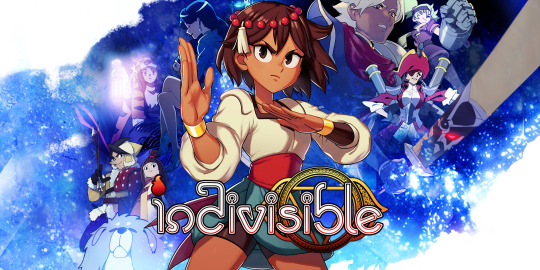
Indivisible [2019]
Mostly only known as the "from the makers of Skullgirls" game, Indivisible is another prime example of a game that was crowdfunded as one thing but turned into another, and gets a bad rap for its association with the ever-present controversiality of Skullgirls' creators. That said, I still think - as always - that it's crucial to view a game for what it is, not what it isn't. And what it IS is an extremely engaging mish-mash of genres and endearing characters, oozing with style and appeal, that fills a very particular void left behind by some of the most classic RPGs of a bygone era.

At its core, Indivisible is a 2D Metroidvania/RPG hybrid with an unusual battle system that plays similarly to an old PSX game series called Valkyrie Profile. During combat, each character's gauge will fill up, allowing them to take action(s). Your four party members are each assigned to one of the four face buttons on a controller (e.g. A, B, X, Y), and pressing that button will - in real-time - execute an attack on the enemy. Using it in combination the D-Pad allows for several different types of attack. All party members' attacks can overlap simultaneously, allowing you to string together combos to really rack up the damage, or juggle enemies to prevent counterattacks and break their defenses. The Metroidvania and platforming portion comprises the rest of the game, with a heavy focus on using those same action skills to scale massive environments, solve platforming puzzles, and dodge spikes. Typical Metroidvania stuff.
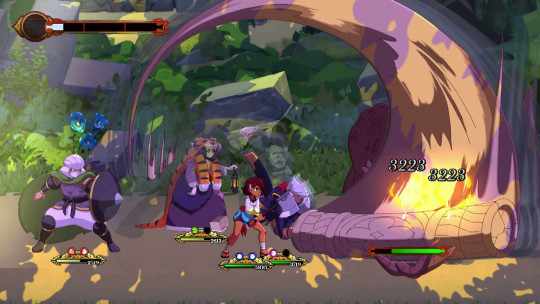
Story-wise, in our modern world of RPGs that is dominated almost exclusively by Japanese and Scandinavian narratives, Indivisible is breath of fresh air that focuses heavily on South and East Asian mythology and themes. Heavy inspiration is taken from the cultures of India, Tibet, Mongolia, and the South Pacific. This is reflected not only in the characters and their various ethnicities, but in the game's approach to spirituality, reincarnation, second chances, and being a teenager hellbent on destroying god. Our main protagonist Ajna is a teenager studying martial arts who isn't quite as in touch with her spirituality as her mentor would like her to be. When war strikes the land and burns her home to the ground, she gets pissed and sets out on a quest for retribution, discovering in the process that she actually does possess certain godlike powers of destruction, and also that she can absorb certain people into her head, which is just a cute way of lampshading having a Party System.
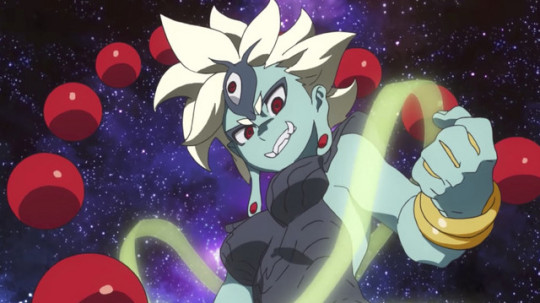
I've seen Reviewers and big Opinion-Havers on the internet criticize the game's writing for having a bull-headed protagonist who boldly rushes into confrontation, unleashing her wanton destruction without first considering the catastrophic consequences for civilians. It's almost like they've forgotten what being a teenager and making poor choices is like. But I say fuck 'em. I say we need MORE stories about uninformed teenagers with immense godlike powers and no sense of nuance making rash decisions and fucking up royally. That alone is crucial to understanding the rest of the game's themes about atonement, reincarnation, and understanding why you believe what you believe in. That's what Indivisible is all about. In many ways, I feel like Ajna shares a common story arc with Korra from the Avatar series, and it's very cool to see how she learns to deal with the damage she's caused and what insight that gives her when facing down the Big Bad.
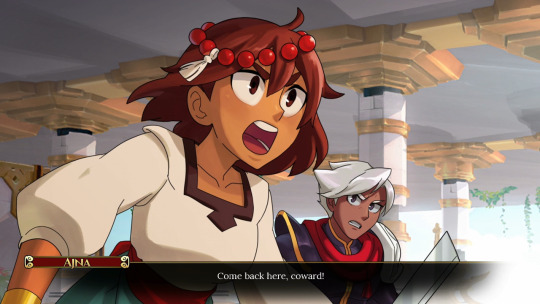
Of course, what is a good story without characters to flesh it out? The characters in this game are absolutely charming and multifaceted, coming from a wide array of different cultures and personalities, many of which are vastly underrepresented in not only RPGs but video games in general. Personal favorites include, but are not limited to, big booba water mom Thorani (based on a buddhist deity of the same name), Leilani the Hawaiian sharknado (spins around in a cyclone attack using a leiomano, a Hawaiian shark-tooth sword), lesbian pirate mom Baozhai (based on the famous Chinese pirate Ching Shih), and of course, local nihilistic swamp witch Razmi (a loose mishmash of Korean and Persian Zoroastrian shamans). The full cast of characters is enormous (well over 20 playable ones alone), and each one comes with a unique moveset and playstyle that not only keeps gameplay interesting, but matches their personality and the role they play in the story.
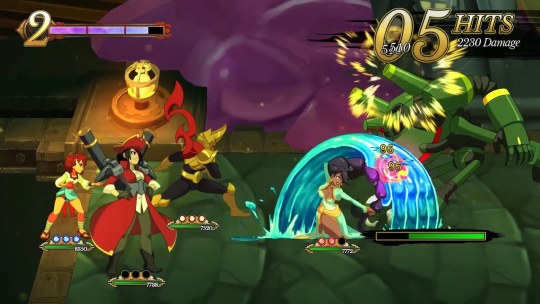
But if there's one thing I truly want to focus on when I gush about this game, it's this. Indivisible has one thing over most other games of its genre, something that modern RPGs in particular suffer heavily from a severe lack of, and that's its strong commitment to multiculturalism. Indivisible made a clear decision to not only feature characters from around the globe, but to blend their cultures together in interesting and exciting ways that don't diminish or water them down. Every character is allowed to shine in their own way without diluting what makes them stand out in the first place, which is why you can have a game that features a gunblade-wielding cowboy, a Namibian songstress, an armless Chinese dancer, a Kamen Rider knock-off, and a Mongolian archer who people keep mistaking for Pearl from Steven Universe. This sort of melting-pot cultural stew used to be common in classic anime and 90s RPGs, but kind of fell out of fashion with the rise of gacha waifu games and Elder Scrolls derivatives. Now more than ever, I feel like Indivisible is exactly the sort of injection the gaming world needs to rekindle those flames of pure imagination that the old classic era brought us.
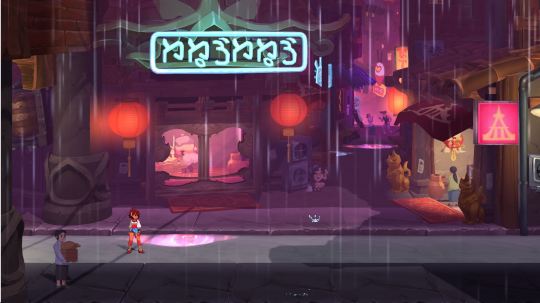
All that said, one of the biggest reasons Indivisible will always have a dark mark next to its name is of course due to the fact that its lead designer (the studio head) was involved in a sexual harassment case that resulted in everyone on the team either quitting or being laid off, and the rights to the work and characters getting lost in the shuffle. Additionally, the game was still finished and released as intended, but did not feature any of the guest star characters that were promised during crowdfunding, most of whom were indie darlings of the time (Shovel Knight, Hyper Light Drifter, and Super Time Force to name a few). Naturally, this has left a sour taste in many folks' mouths, so it is somewhat understandable why the game would have a negative stigma attached. There are also a few bizarre and possibly off-putting cameos hidden among the NPCs (a few outdated meme references and Zone-tan, of all people), but these are entirely skippable and serve only as background extras.
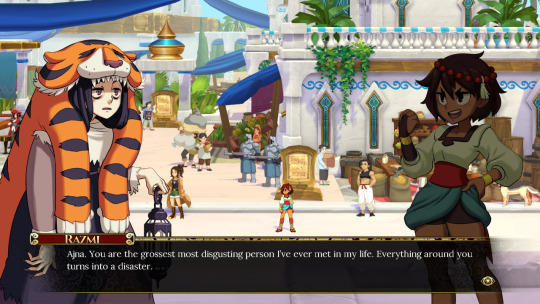
Sour grapes aside though, I wholeheartedly recommend Indivisible for anyone looking for a fresh take on action RPGs. The neat hybridization of Metroidvania and real-time RPG with fighting game mechanics gives it a very unique identity, and if the compelling spirituality of the story doesn't grab you, the charm of the characters absolutely will. It certainly took me for a ride. My only word of caution is to follow the game's own suggestion and get good at Blocking in combat as early as you can!
112 notes
·
View notes
Text
listen! MARco, MARcel, MARlowe, MARley: do they only point to war from the god mars (ares), as in martial? three boys dead in marley's war, and only marcel knew it. the seven visible planets have their metals in medieval alchemy: ♂ is iron, the stuff of weapons and armor, spear and shield, forged in fire into steel.
or, is it also the sea: marinus, where we get marine, maritime, and ultramarine, the precious pigment from ground lapis lazuli named not for its deep blue color, but for coming to europe from beyond the sea (the middle east). armin is even an anagram for the old french marin.
add nile dok's widow, MARie, ymir fritz's daughter and wall MARia: marley attacked maria, eren of maria attacked marley. maryam, mother of god. hildegard von bingen called her stella maris, sea star. or the scout squad leader who died in shiganshina, MARlene, whose name i chuckled at as if yams just googled famous germans, but i want to give him credit for this repetition. it's too beautiful and double edged.

#this coming from your local astrologer/theologian/sailor mars kin#sorry i think this is my biggest brained aot meta moment so far#aot meta#aot#marco bodt#marlowe freudenberg#marcel galliard#armin artlert#marie dawk#marie dok#nile dok#nile dawk#marco bott#♃#aottxt#armin arlert
28 notes
·
View notes
Text
the fact that guzi is like 7 years old and has already met every supreme ghost king and literally been to heaven. dude had the craziest year of his fucking life and then got adopted (reluctantly) by the martial god of the east
29 notes
·
View notes
Text
ART HISTORY WORD LIST [part 2]
구조 [構造] - structure
왕릉 [王陵] - royal tomb
계급 [階級] - class, rank
장식되다 [裝飾되다] - be decorated
정면 [正面] - facade front
분담하다 [分擔하다] - to share
설화 [說話] - tale
별자리 - star constellation
도교 [道敎] - Taoism
고분 벽화 [古墳壁畫] - tomb fresco
권위적 [權威的] - authoritative
천장 [天障] - ceiling
승려 [僧侶] - Buddhist monk
공양하다 [供養하다] - to offer food to Buddha
기상 [氣像] - spirit
배치하다 [排置하다] - to arrange
웅혼하다 [雄渾하다] - dynamic
원근감 [遠近感] - perspective
설채 [設彩] - to draw background with ink and then color it
씨름 - korean wrestling, ssireum
유래되다 [由來되다] - to originate
무예 [武藝] - martial arts
색채 [色彩] - tone (color)
내세 [來世] - afterlife
귀족 [貴族] - aristocracy
제왕 [帝王] - emperor
사신 [四神] - Four Symbols - four mythological creatures appearing among the Chinese constellations along the ecliptic, and viewed as the guardians of the four cardinal directions. These four creatures are also referred to by a variety of other names, including "Four Guardians", "Four Gods", and "Four Auspicious Beasts". They are the Azure Dragon of the East, the Vermilion Bird of the South, the White Tiger of the West, and the Black Tortoise of the North. Each of the creatures is most closely associated with a cardinal direction and a color, but also additionally represents other aspects, including a season of the year, an emotion, virtue, and one of the Chinese "five elements" (wood, fire, earth, metal, and water). Each has been given its own individual traits, origin story and a reason for being. Symbolically, and as part of spiritual and religious belief and meaning, these creatures have been culturally important across countries in the East Asian cultural sphere.
청룡 [靑龍] - Azure Dragon, Blue Dragon
백호 [白虎] - White Tiger
주작 [朱雀] - Vermilion Bird, Red Phoenix
현무 [玄武] - Black Tortoise

#korean#word list#korean vocabulary#korean language#langblr#learning languages#language study#foreign languages#language blog#korean word of the day#hangul#hanja#korean history#korean art#한국어#한국미술사
#korean#foreign languages#language study#korean word of the day#langblr#korean language#korean history#korean art#한국어#hanja#hangul#word list#한국미술사#korean culture
33 notes
·
View notes
Note
What is lion dancing? You've mentioned it before, but I don't think I've seen it before
I'm particularly new to the world of lion dancing myself, but I hope this could also help! Lion dancing is a Asian tradition that blends puppetry, martial arts, and dancing that has been around 206 BC. Although it originated from China, countries like Japan, Korea, Vietnam, and South-East Asian countries have their own respective forms of lion dancing. There's actually quite a few types out there, but they can be identified by their martial art forms, lion heads, or nationalities. I'm probably going to info dump now so I'll cut it here for others to read if they'd like.
Before we get into that, I have to clear some common misconceptions. Lions are NOT dragons. Dragons are puppets that generally have 6 or 9 people holding it up on poles and are long (龙 lóng - do you get the joke lol). Foo dogs are technically lions, but the terminology was derived from white people who mistook lions as chow chow dogs.


To clear further confusion, the reason they're called lions is because allegedly, when China started trading with the western world, lions and their pelts were only reserved for the wealthy. Poor people spread word about what lions looked like, and it somehow turned out that way. There's a lot of mythology surrounding why people do lion dances, but the shorter version is that the lion scares off demons and ill-intentioned spirits from villages. It's now a tradition at openings of businesses, weddings, funerals, and festivities.
Most people are generally used to seeing southern Chinese or Cantonese lions. Traditionally, all of these lions are male and have different variations, again based on nationality or style of martial arts that it's derived from. There are northern lions, which have a male and female (red and green bows respectively), as well as Japanese and Korean lions, which are mostly comprised of wooden masks and long fur.
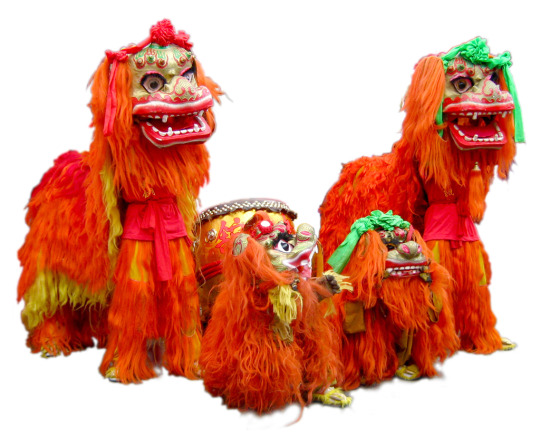
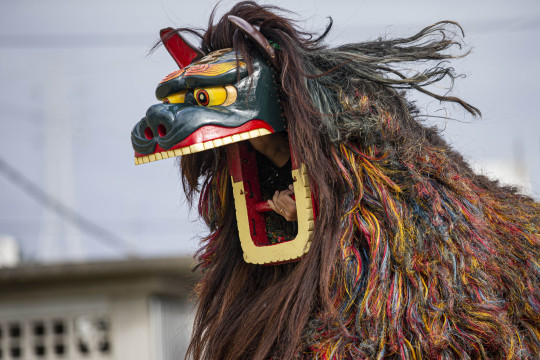
I'll mostly focus on southern Chinese lions, but they're all pretty neat! I mostly practice Fut-San lion dancing, which is a pretty common form. They notably have a ":3" face and the style of martial arts (wushu) is considered a very common standard for southern Chinese lions. Recent variations of these lion heads also have pom-poms as they are derived from Beijing opera costumes. Each lion also has a pointed horn on the top. They can also have fluffy or wiry fur for its eyelids and mouth, but there exists variations with bristles instead, which may signify that the lion is based on a historical military figure (kind of similar to how Beijing opera singers do specific makeup for specific characters).
These are generally more common in other countries. South-east Asian versions of the lions are extremely decorated, intricate, and distinct.

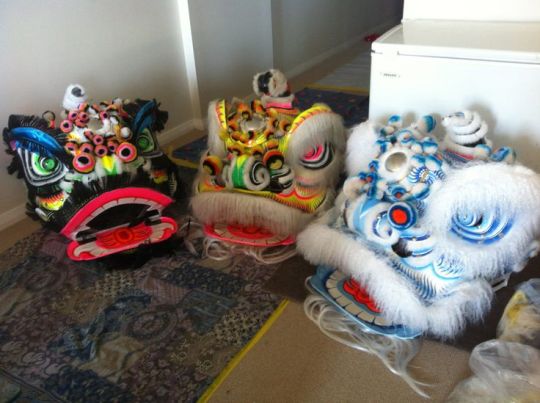
Hok-San lions are also pretty common. They are distinguished by having a "snake" horn which means the horn curls into a circle at the end and a ":)" face.
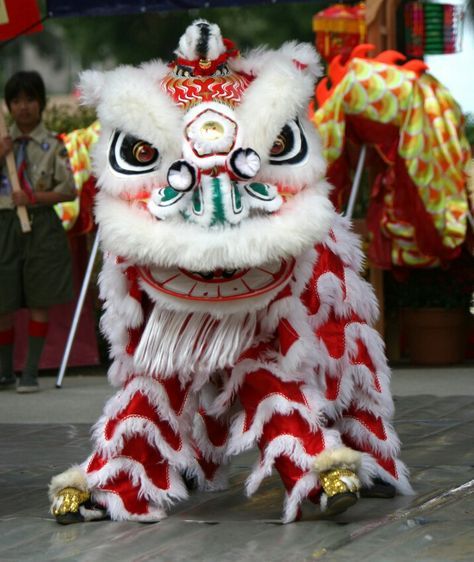
Despite their differences, all southern lions have a mirror in the front to ward off evil spirits, some horn with a bow attached, and a beard. Traditionally, the mirror is there to scare off spirits who look into it. The horn is generally added after the lion is almost finished being made, and the bow on the horn is added ceremoniously to bless the lion and honor the gods. It is highly recommended people don't touch them, save for the practical reasons of dirtying the mirror or tearing off the delicate horn, but also to avoid getting bad luck from ill-intentioned spirits.
That aside, I'd like to finally to talk about what to do when you see lions! If you have red pockets of money, the lion eats them up (and the performer in the head puts everything in their sweaty shirt). Sometimes, lions go and play with the audience, so feel more than welcome to pet them or play fight with them! Each performer has their own distinct personality that they play in the lion and as a result, have a lot to share with the audience!
I could go on and on, but I'm afraid this is really long for no reason. I hope this info dump helped!
51 notes
·
View notes
Text
MY THOUGHTS ON DRAGON BALL DAIMA
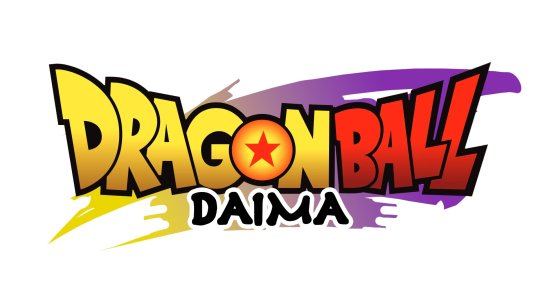
(Wasn't going to post this old draft, but decided to post it anyway since @/puyohero was curious about my thoughts)
Awesome! Love that Toriyama is heavily involved! Love the art & animation and the idea is interesting too.
SIMILARITY TO DRAGON BALL GT
Yes, GT did something similar. However GT sidelined most of the cast. Even Pan & Trunks kinda got sidelined when they were part of the main cast of GT. In this, it seems the other characters will play some sort of role too. Or I assume so. And they will be traveling to another realm/world. So maybe the others will go with Goku.
DB DAIMA seems to be referencing a lot of DB properties & not only GT. As pointed out here...
CAST AS CHILDREN COULD MEAN...
I had hoped it would turn the entire cast into children and glad it happened. Now I hope we get more info about it. Because what I want is for the other cast members to get involved. Gohan & Piccolo are on a similar level to Goku & Vegeta, so then being excluded to only focus on Goku & Vegeta would be stupid. And since it is stated that this series won't be transformation heavy... what if Goku cannot transform into forms he didn't have as a child?? Or it's very taxing on the body if they can. Now everyone can get involved in the battles! Krillin has already returned to martial arts, but we can get my boy Yamcha fighting again! We might even get to see kid Ox King fight alongside kid Roshi. That would be neat!
Now what would be funny is to see a kid version of Buu. Would it be a short chubby Buu or Kid Buu/Pure Buu? Or maybe the magic won't affect him much since he can change his appearance at will. 🤔
Also, I bet there is a joke about Krillin not getting much smaller when turned into a kid again like how there was a joke in OG Dragon Ball that Krillin didn't get much taller & Krillin is upset about the statement.


Also, the chibi reminds me of the Dragon Ball SD manga.
TITLE POSSIBLY ELUDING TO...
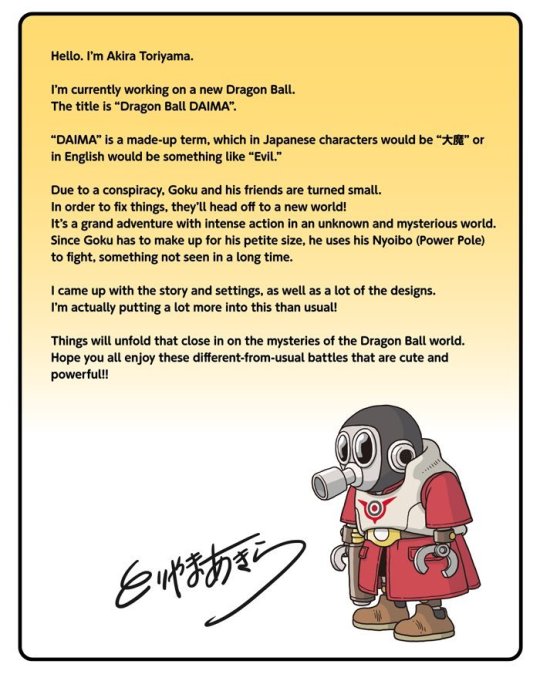
Another interesting thing was the placeholder name "Magic" and the current name "DAIMA." Seems like Toriyama is possibly hinting at the Makaioshin. Evil beings with magical power, the Demon Realm being a place where magic rules over science, and the fact that THIS guy looks like a Kaioshin.

So the little guy could be a God of the Demon Realm. Or maybe a God of Destruction of the Demon Realm. Who knows? We'll have to wait and see.
JOURNEY TO THE WEST REFERENCES
I see some Journey To The West/Saiyuki influence in here too which is good cause this is Dragon Ball after all. Goku with a Sun Wukong role, East Kaioshin (Shin) with the monk role. And maybe other characters who are inspired by Saiyuki will play roles similar to their inspirations.
Vegeta having a Sun Wukong role while Bulma has the Tripitaka role
Piccolo having a Tripitaka/Wukong role while Gohan also has the Tripitaka/Wukong role
Krillin with a Tripitaka role (maybe some Wukong role too since he also takes some Wukong inspiration) & maybe 18 takes on the role of Tripitaka in certain aspects?
Yamcha with a role referencing Sha Wujing role
Tenshinhan with a role referencing Erlang Shen
And if the Demon Realm is involved then there is more Saiyuki references. Journey to a dangerous land and fighting demons. This could be pretty cool to see.
GOKU'S DESIGN
And another thing... Goku's gi in Daima. It's becoming closer and closer to his End of Z gi.
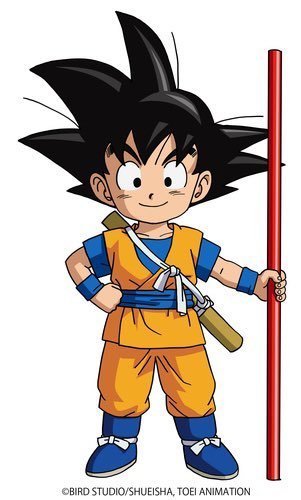


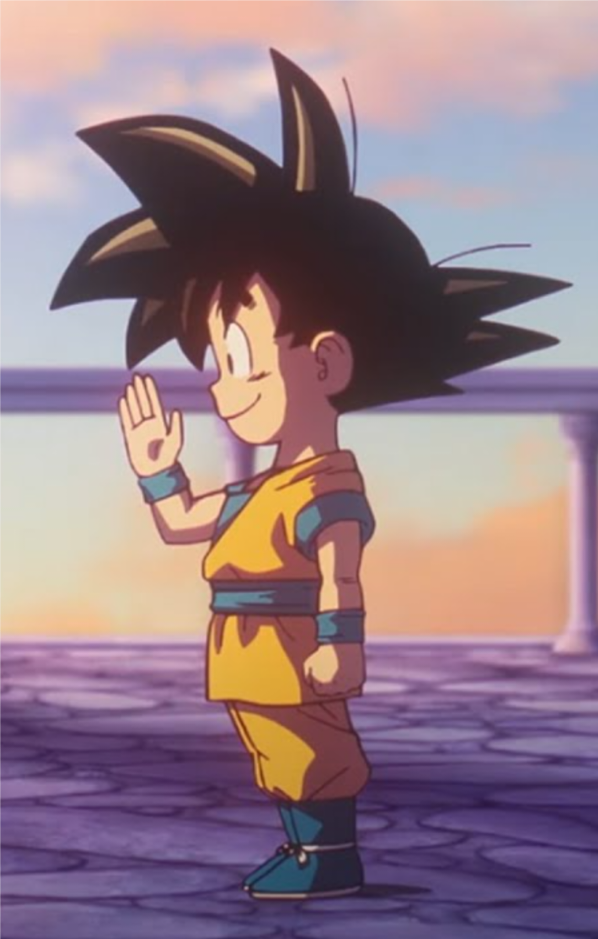

The untucked style of Goku's gi in Daima is similar to EoZ, but the colors are still like his iconic orange and blue gi.
MY THEORY FOR THE STORY
In the Demon Realm, the Makaioshin & some Demon God examine Goku & his friends. They speak about Babidi and how he recruited the King of the Demon Realm, Dabura, and still failed. As well as Bibidi summoning & Babidi reawakening the evil beings Majin Buu, then Buu becoming an ally of Goku. Where a sorcerer failed, a Demon God plans to succeed. The Demon God & Makaioshin notice that Goku & company are always victorious due to their strength, transformations, and friendship that encourages each other. So somehow, they are all turned into children to make them doubt their chances of victory. And their power is nerfed too. The Saiyans might have to struggle just to turn SSJ again. I believe it will be through a spell just to be different from GT and not use a wish granting Dragon. The part that shows that a wish was made to Shenron wish was likely after they were turned into kids and they needed help in some way, or they tried to reverse the spell and it was beyond the power of Shenron.
So they venture into this new realm to fix things. Perhaps splitting into groups. Goku & Kaioshin, Vegeta & Bulma, Gohan & Piccolo, Krillin & 18, ect. Some teaming up with other groups too. Get to see stuff like Goku & Tien team up. They learn about the depths of magic & Bulma is surprised because her technology she relies so much upon doesn't matter much in the Demon Realm where magic is their technology.
At some point, they find a way to return to their actual ages and adult bodies. In the end, they confront the Demon God & Makaioshin. Of course Goku would face the main bad guy (along with Vegeta & maybe with Gohan & Piccolo). Godly power vs godly magic. Or something like that.
Now let's wait & see how wrong I am 😂
#Dragon Ball DAIMA#DB DAIMA#DB#Dragon Ball#DBZ#Dragon Ball Z#DBS#Dragon Ball Super#Goku#Son Goku#Krillin#Kuririn#Toriyama#Akira Toriyama
25 notes
·
View notes
Text
The Ultimate
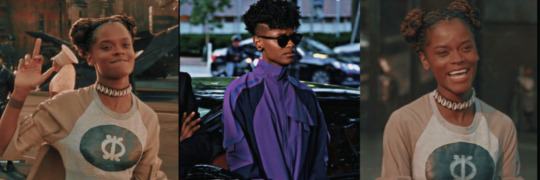
Shuri x Fem!reader
Warning: None. Like 840 words
Part 1
⎽⎼⎻⎺⎺⎻⎼⎽⎽⎼⎻⎺⎺⎻⎼⎽⎽⎼⎻⎺⎺⎻⎼⎽⎽⎼⎻⎺⎺⎻⎼⎽⎽⎼⎻⎺⎺⎻⎼⎽⎽⎼⎻⎺⎺⎻⎼
East of Wakanda a Tribe living only out of Vibranium, however only 2 left made fully out of the source. Queen Hadi and her husband and King Malik. Together they had only one child.
This child came to be be name Princess Y/fn of the Adamma tribe. Better known as the lost tribe of Marrakech.
Born October 10th, 2004. The strongest beings in the world. Born with multiple powers that she had to train everyday , but babies don’t know how to control things.
Willingly at least.
Telekinesis, Hydrokinesis, Aerokinesis, Geokinesis, and Super Strength.
At 5 she was excepted to learn seven languages at the same time. Was this easy on a child no…of course not. But she did surprisingly well, and by 8 she knew…
- Kech ( Mother tounge ) not counted
-Spanish
-English
-French
-Russian
-Korean
-Japanese &
-Xhosa
At age 9 Y/fn made such advanced technology they created a passage to the quantum realm that only they have access to making them the first of human kind to start civilization there.
At age 10 her mother wanted her to experience the best of life. She thought training her so much at a young age would create a cold blooded killer. Working around chemicals all day didn’t help either.
So they was sent on a trip to North America. Specifically the US. She grew to hate how self centered the people were.
How they consistently harmed their own kind.
How lazy and unfair their laws where.
This did take a toll on her causing her to see how the world really works. Her own people being murdered and mistreated. She does not smile often and has been taught to show no emotion but she could not help but to feel constant aching in her chest when these things happen.
At age 13 they returned home and continued to train. This did not surprise her mother. She was only there for 3 years.
But one day in the US can make you want to blow your brains out.
At the age of 14 she started to perfect her powers. This was not a must but purely for fun. Best part about made of Vibranium is you technically can’t die.
Brute force is one way to destroy the metal, but only if one possesses the strength of a god.
By 15 she was titled The Ultimate by her mother, her father, her people.
Her parents didn’t want her to waste away being that nothing was after them. So they did something.
At 16 the Avengers recruited her.
This can happen if you have an exceptional power or skillset, and happen to catch positive attention from a current member. But in her case her parents made them.
Not that she had a problem with it but come on. Going out and saving people willingly was in no way shape or form better than staying home in her comfortable bed.
Captain America, Iron Man, Thor, Hulk, Black Widow, Scarlet Witch, Spider-Man, Nebula, Rocket, Captain Marvel, Okoye, Black Panther, Ant-Man and more.
Her favorite being Okoye & Black Panther. She considered them ‘her home away from home.’
Okoye is an skilled martial artist and master of staff and spear fighting. She carries a specialized vibranium spear, capable of collapsing into a handle for quick concealment.
A weapon traditionally wielded by members of the Dora Milaje. An elite group of warriors who serve as the all-female special forces for Wakanda.
They also serve as the Black Panther's personal bodyguards. Also known as Prince T'Challa the King of Wakanda and the eldest child of T'Chaka and Ramonda.
⎽⎼⎻⎺⎺⎻⎼⎽⎽⎼⎻⎺⎺⎻⎼⎽⎽⎼⎻⎺⎺⎻⎼⎽⎽⎼⎻⎺⎺⎻⎼⎽⎽⎼⎻⎺⎺⎻⎼⎽⎽⎼⎻⎺⎺⎻⎼
She loved the thrill fighting gave her but before she returned back to her home Prince T’Challa suggested that she goes back with them because they wanted some new weapon ideas and he wanted her to be there when he was crowned king.
To which she agreed. She was going to come back even if she hadn’t to check out some of their technology.
When they landed back in Wakanda she was introduced to The Princess.
Possessing one of the most brilliant minds in the world. Princess Shuri, she also the chief science officer for Wakanda, a position she cherishes much more than her royal status.
“Hello I am y/fn Adam- ” You began quickly getting cut off making her stand with wide eyes.
“I know- I am sorry it is just that I am a huge fan. I have never met anyone made out of Vibranium this is so cool.” The Princess said quickly.
You smirked.
‘Praise kink is on 100’
“I am a big fan of you to. I heard about your Vibranium Gauntlets and theyare absolutely amazing.” You say in awe.
“What a cute little nerd moments they are having.” T’Challa said out loud earning a quick slap to the arm from his mother and a chuckle from Okoye.
You looked around the beautiful land as they spoke. “Could I show you some of my new inventions. I could use an smart persons opinion.” Shuri asked.
“Of course” You replied waving at the others while she held other hand leading you to her lab.
That is where it all started.
————————————————————————————
#wakanda forever#shuri x black!reader#shuri imagines#shuri udaku x reader#shuri x y/n#shuri x black reader#shuri x black female reader#wakandans#tchalla x fem!reader#shuri udaku#king of wakanda
153 notes
·
View notes
Text
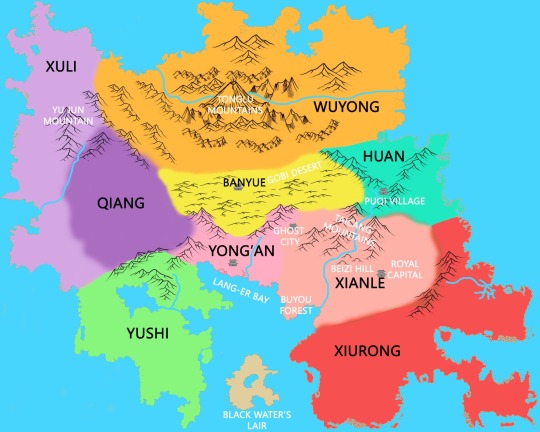
Fan made TGCF Map!
*Qiang, Huan and Xiurong are all fanon kingdom names.
--> Qiang is the kingdom of Yin Yu/Quan Yizhen
--> Puqi Village I feel would've been noted if it was in specific already named kingdom, so I put it in its own. Huan would be written as 欢 - the word for Happy/Joyful.
-->Xiurong is what happens when the Martial Gods for the Southeast/Southwest are technically both from Xianle. Since Xianle is in the Central Plains, there had to be some kingdom southern to it.
*Ghost City is said to be in the East/Lang Qianqiu's territory but is also noted as being near the Taicang Mountains. Since LQQ is from Yong'an I settled the Ghost City to the east of the original borders of Yong'an and to the west of the Taicang mountains.
*Yong'an and Xianle have very similar colors since they were both originally Xianle, yet both become Yong'an. Technically both have fallen since then and the area is a new unnamed kingdom.
186 notes
·
View notes